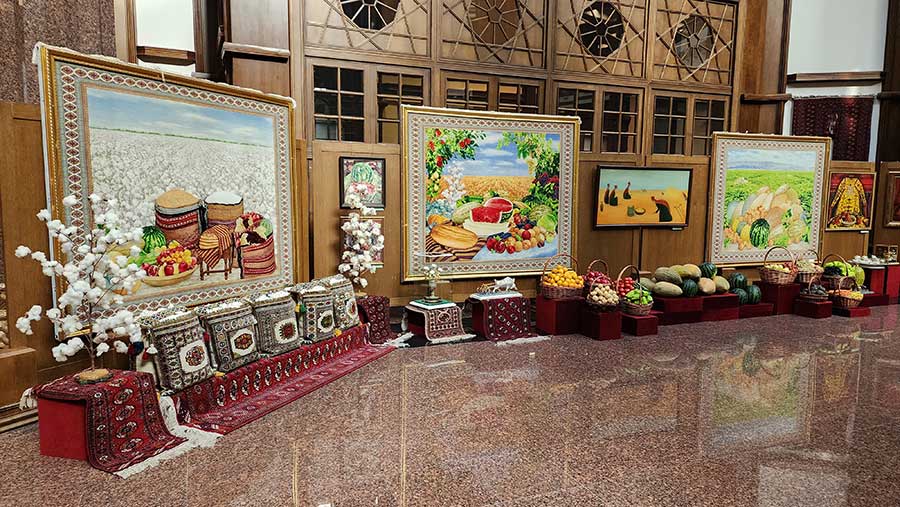The harvest festival is celebrated annually in the country by the decree of the President of Turkmenistan. This is a clear demonstration of the state's great attention to the labor of agricultural workers. Today, in honor of the holiday, an exhibition entitled "Gratitude for Selfless Work" is being held at the State Museum of the State Cultural Center of Turkmenistan.
The exhibition is dedicated to agricultural workers and is divided into two thematic sections. The first one tells about the modern achievements in agriculture during the years of our country's independence. The exhibition is adorned with carpet panels depicting golden fields, vast cotton fields, melon crops, as well as abundant harvests of fruits and vegetables. The exhibition is also decorated with sheaves of white wheat and horjuns filled with fine cotton and silkworm cocoons. Works of jewelry masters are also presented: cotton bushes, wheat ears, grape clusters, created from imitation stones and metal.

The second section of the exhibition is dedicated to the history of the emergence and development of agriculture in Turkmenistan. The discovery of the first signs of settled agriculture in Central Asia in the ancient settlement of Jeytun (northwest of Ashgabat) is an important historical event. The first cultivated fields were located at the foot of the Kopetdag, near mountain springs, in lowlands that were flooded with water in the spring. In irrigated areas, the settled population gradually adapted to the practice of basic agriculture.
Artifacts found in ancient agricultural settlements are displayed in the exhibition showcases. These include ancient grain grinders, a mortar and pestle, sickles, symbols of fertility, and objects of worship for farmers in the form of female statuettes.
In 1904, during excavations led by American archaeologist R. Pumpelly, grains of white wheat dating back to the 1st millennium B.C were found on the hills of Anau. Since then, Turkmenistan has been considered the homeland of white wheat. A valuable exhibit - imprints of white wheat grains on gypsum can be seen at the showcase.
The history of agriculture development in Turkmenistan is dedicated to the 1930s-1950s. The photographs from those years depict cotton fields, cotton pickers, the first tractor, lively moments of harvest and selfless work of rural laborers. The exhibition is adorned with a Turkmen yurt and antique household items of the Turkmen people.
The exhibition opening was attended by representatives of the mass media, teachers from the Turkmen Agricultural University named after S.A. Niyazov, employees of the Research and Production Center and the National Institute of Deserts, Flora, and Fauna of Turkmenistan, as well as representatives of the Ashgabat Committee of the Agrarian Party of Turkmenistan.
Enejan Altyeva,
Head of the Department of the State Museum of the State Cultural Centre of Turkmenistan.







